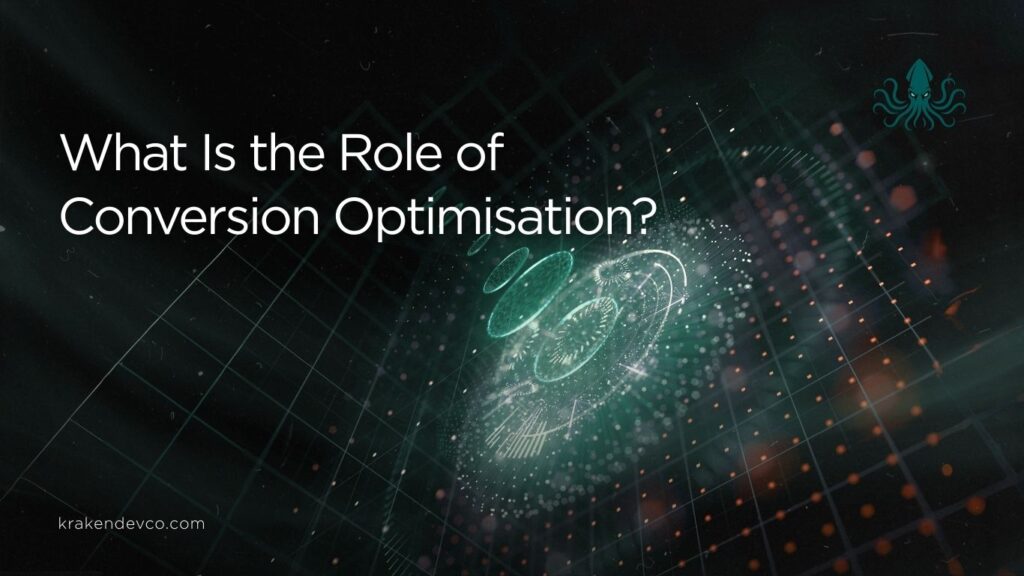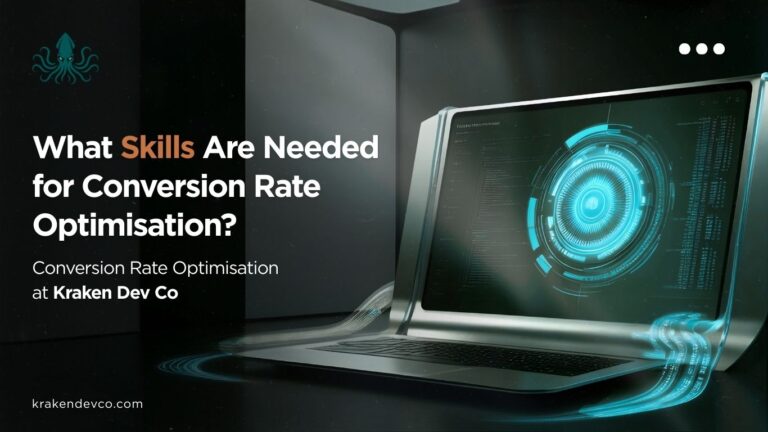
Stop Wasting Traffic. Start Engineering Conversions.
Conversion optimisation isn’t an optional enhancement. It’s core infrastructure. Most websites attract traffic. Few convert it. If your site bleeds users at every scroll, click, and bounce, you don’t need more traffic—you need better engineering.
At Kraken Dev Co, conversion rate optimisation (CRO) is a discipline, not a tactic. We map friction, rebuild funnels, and rewire UX for results.
What Is Conversion Rate Optimisation?
Conversion rate optimisation is the systematic process of increasing the percentage of website visitors who complete a desired action. That action could be a purchase, a form submission, or a newsletter signup. The formula is simple:
Conversion Rate = (Conversions ÷ Visitors) × 100
But the execution is rigorous. We use behavioural data, user feedback, A/B testing, and analytics tools to identify friction and convert attention into action.
It’s not about gimmicks or guesswork. It’s structured, strategic, and statistically grounded.
Why CRO Matters
Without CRO, your digital marketing spend is inefficient. You’re driving traffic without a performance engine. Here’s what robust CRO unlocks:
- Higher revenue per visitor
- Lower customer acquisition cost
- Improved marketing ROI
- Scalable lead generation
- Accelerated sales cycles
Clicks don’t pay the bills. Conversions do.
In competitive markets, margins are thin. CRO improves them. You already paid for the traffic—now make it work.
Define Your Conversion Goals
Before testing begins, define success. Conversion goals depend on your business model:
- Ecommerce websites: Add to Cart, checkout page completions
- B2B websites: Contact form submissions, demo bookings
- SaaS: Trial signups, plan upgrades
- Media: Newsletter subscriptions, ad click-through conversions
Never benchmark against industry averages. Use your own analytics platform—like Google Analytics 4—to establish a reliable baseline.
Segment goals by funnel stage:
- Top of funnel: Lead generation, email signups
- Mid-funnel: Content downloads, product exploration
- Bottom funnel: Conversions, repeat purchases
Start With the User
Effective CRO starts with understanding user behaviour. That means real data, not assumptions:
- Heatmap tools and session recordings (e.g. Crazy Egg, Content Square)
- Funnel analysis and multivariate testing
- Voice of customer via surveys, feedback tools, and user interviews
- Behavioural insights from A/B testing platforms and user testing specialists
We diagnose the conversion funnel through the lens of:
- Drivers: What brought users to your site?
- Barriers: What’s stopping them?
- Hooks: What persuades them to act?
Everything begins with a clear understanding of the data. Conversion metrics without context are meaningless.
Our 5-Step Conversion Optimisation Framework
1. Define High-Value Conversion Events
What is a conversion event for your business? It could be reaching the pricing page, completing the checkout page, or submitting a lead form.
We track both macro and micro conversions. Micro conversions include video plays, scroll depth, or Add to Cart actions. These are leading indicators of user engagement.
2. Analyse the Conversion Funnel
Where do users fall off? Is it the product page, shopping cart, or final checkout? Funnel analysis using Google Analytics, heat mapping, and bounce rate tracking reveals where to focus.
We combine qualitative insights from session recordings with quantitative data from analytics platforms.
3. Form Data-Backed Hypotheses
We use conversion variables like page speed, copy clarity, call to action placement, and trust signals to formulate high-impact test scripts. Examples:
- “Improving mobile responsiveness on product detail pages will reduce abandoned cart rate.”
- “Adding customer testimonials and trust badges to the landing page will increase conversion rates.”
Hypotheses are prioritised using the PIE framework: Potential, Importance, Ease.
4. Run A/B Tests and Split Testing
Using A/B test developers and testing tools, we measure:
- Micro conversions and conversion metrics
- Statistical significance
- Multivariate interactions
We deploy split testing and multivariate testing to isolate which conversion variables drive results.
5. Optimise Relentlessly
CRO isn’t a one-time campaign. It’s ongoing infrastructure. Testing and tweaking based on user feedback, session data, and analytics platforms keeps performance compounding.
We document learnings. We refine hypotheses. We ship improvements.
High-Impact Zones for CRO
- Landing page design: Cut distractions. Focus copy. Align with marketing campaigns.
- Product page and pricing page: Clarify features, reinforce value, segment by use case.
- Checkout page: Remove friction. Offer trust signals. Reduce steps.
- Forms: Minimise fields. Use progress indicators. Validate in real-time.
- CTAs: Use outcome-oriented language. Place above and below the fold.
- Site structure: Streamline user flows. Prioritise user-friendly website navigation.
- Mobile app and mobile optimisation: Design for thumb-first interaction. Test across mobile devices.
You don’t need more pages. You need more performance from the ones you’ve got.
Advanced CRO Tactics
Personalisation and AI
Leverage AI-powered product recommendations, dynamic content, and adaptive CTAs based on user persona and behavioural segments.
Behavioural Segmentation
Use analytics tools to segment by:
- Device type
- Traffic source
- Demographic data
- Session behaviour
Deliver tailored conversion experiences across segments.
Integrate With Always-On Marketing
Always-on marketing isn’t useful unless it converts. Feed insights from:
- Email marketing
- Paid media campaigns
- Social channels
…back into your CRO system. Every touchpoint should optimise for action.
Trust and Social Proof
- Display verified customer testimonials
- Highlight average order value to establish trust
- Use trust badges near key CTAs
Trust converts. Period.
Avoid These Common CRO Mistakes
- Running A/B tests without a clear hypothesis
- Ignoring mobile responsiveness and mobile optimisation
- Using metrics like time on page instead of conversion metrics
- Neglecting user personas and customer insights
- Relying on visual design over data-driven UX
- Skipping voice of customer feedback
- Forgetting to align testing with business goals
- Disregarding statistical significance and test duration
Every test must be engineered with intent.
Align CRO With SEO and Paid Media
Conversion optimisation isn’t a silo. Integrate it across digital marketing strategies:
- Improve bounce rate and engagement metrics for SEO
- Increase landing page performance in paid media campaigns
- Align website copy with keyword intent and user behaviour analysis
High-performing sites use CRO and SEO to maximise website ROI.
Measure What Matters
Go beyond conversion rate. Monitor:
- Average Order Value (AOV)
- Cart abandonment rate
- Customer Lifetime Value (CLV)
- Lead flows and funnel velocity
- Website usability and page speed (Page Speed Insights)
- Conversion funnel analysis by segment
- Voice of customer via Surveys Feedback tools
Every conversion event contributes to your revenue engine.
Ethical and Compliant Testing
CRO must respect privacy and compliance. Use GDPR-compliant analytics tools, avoid dark patterns, and prioritise transparency.
Platforms like Matomo provide cookie-less tracking and session recordings.
Make CRO Part of Your Build Culture
At Kraken Dev Co, conversion optimisation is baked into the website creation process. From launch to scale, we ship fast, test hard, and iterate constantly.
Our developers, designers, and strategists work with a CRO-first mindset. This reduces wasted spend and increases website ROI from day one.
We believe in infrastructure. Not hunches. Not hype.
Ready to Stop Wasting Traffic?
Turn every click into a performance lever. Partner with Kraken Dev Co to convert visitors into customers and insights into outcomes.
Conversion is a system. We build it.



